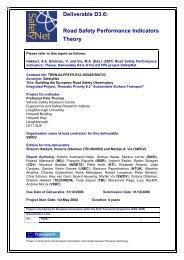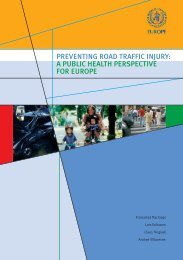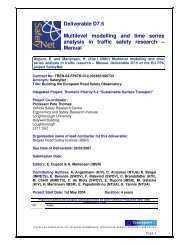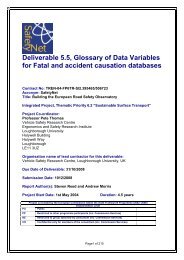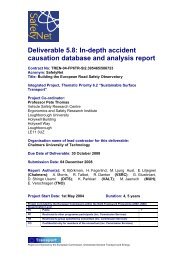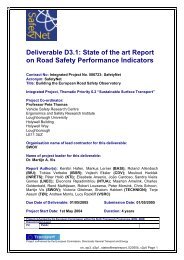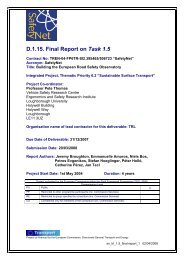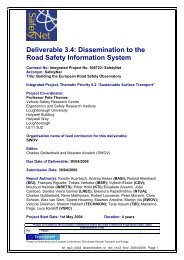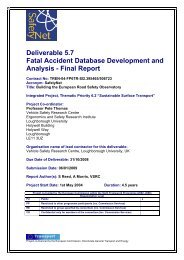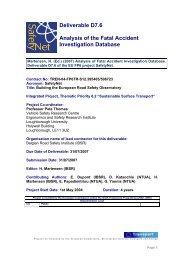Every Accident is One Too Many Every Accident is One ... - UNECE
Every Accident is One Too Many Every Accident is One ... - UNECE
Every Accident is One Too Many Every Accident is One ... - UNECE
You also want an ePaper? Increase the reach of your titles
YUMPU automatically turns print PDFs into web optimized ePapers that Google loves.
Chapter 3<br />
w<strong>is</strong>hes to emphas<strong>is</strong>e the following three<br />
areas where road users need to be<br />
responsible and change their behaviour:<br />
speeding, drink-driving, and driving<br />
without a seatbelt.<br />
The Road Safety Comm<strong>is</strong>sion points to the<br />
fact that individual road user<br />
responsibility and opportunities for helping<br />
to improve road safety through<br />
personal behaviour must be<br />
communicated by means of the most<br />
effective media. Th<strong>is</strong> <strong>is</strong> to say that<br />
electronic media such as telev<strong>is</strong>ion and<br />
the Internet must be increasingly<br />
incorporated in awareness-ra<strong>is</strong>ing<br />
campaigns. Consequently, the Road<br />
Safety Comm<strong>is</strong>sion proposes that more<br />
resources be allocated in future to<br />
preparing special efforts targeted at<br />
electronic media with messages<br />
concerning the importance of individual<br />
road user behaviour.<br />
Finally, the Road Safety Comm<strong>is</strong>sion calls<br />
on road user organ<strong>is</strong>ations and other<br />
private organ<strong>is</strong>ations to accept a central<br />
role as regards influencing individual road<br />
user behaviour and responsibility for<br />
avoiding accidents.<br />
that it be considered whether the fines<br />
collected from such automatic speed<br />
checks could be used to finance local road<br />
safety initiatives. The specific outline of<br />
such a scheme should be d<strong>is</strong>cussed with<br />
relevant local stakeholders and players,<br />
such as local authorities, counties, and the<br />
police, before a final dec<strong>is</strong>ion <strong>is</strong> made.<br />
R<strong>is</strong>k of accident when speeding/drinking and<br />
driving<br />
It <strong>is</strong> important that road users know and respond to the<br />
increased r<strong>is</strong>ks linked with speeding. An Australian study<br />
by researchers at the University of Adelaide shows that<br />
the r<strong>is</strong>k of becoming involved in a road accident <strong>is</strong> equally<br />
great in the following situations:<br />
1. Driving at 20 km/hr in excess of the 60 km/hr speed<br />
limit<br />
2. Driving with a blood/alcohol level of 2.1 o/oo<br />
In both cases, the r<strong>is</strong>k of personal injury <strong>is</strong> increased by a<br />
factor of approximately 30.<br />
Speed<br />
The correlation between speed and accidents <strong>is</strong> very well<br />
documented. Greater speed means greater r<strong>is</strong>k of accident<br />
- and if an accident does happen, greater speed means<br />
more - and more serious - personal injuries.<br />
A five per cent drop in average speeds would typically<br />
entail a drop in the number of serious personal injuries by<br />
between 10 and 15 per cent. The number of deaths would<br />
drop by more than 20 per cent.<br />
20<br />
30 TIMES THE RISK<br />
In urban traffic, a five per cent drop corresponds to a drop<br />
in average speeds from 51.5 km/hr to 49 km/hr.<br />
Thus, increased efforts from the police and road authorities<br />
to reduce speeds would yield very significant results.<br />
The Road Safety Comm<strong>is</strong>sion recommends<br />
the allocation of the necessary funds to<br />
establ<strong>is</strong>h a nationwide system of<br />
automated speed checks, if the current<br />
experiments prove successful. Especially<br />
on roads or in areas where road accidents<br />
are frequent, road safety would benefit<br />
from nationwide automated speed checks.<br />
In order to increase public support for<br />
nationwide automated speed checks, the<br />
Road Safety Comm<strong>is</strong>sion recommends<br />
1075 km/hr<br />
1<br />
1,2<br />
0,8<br />
0,5<br />
70 km/hr<br />
65 km/hr<br />
60 km/hr<br />
80 km/hr<br />
Blood/alcohol level, ‰ Speed R<strong>is</strong>k index<br />
Figure 5. Correlation between speed and drink-driving. The r<strong>is</strong>k <strong>is</strong><br />
set at 1 at a blood/alcohol level of 0 and an average speed of 60 km/<br />
hr (corresponding to the 60 km/hr speed limit in Adelaide, Australia)<br />
19



